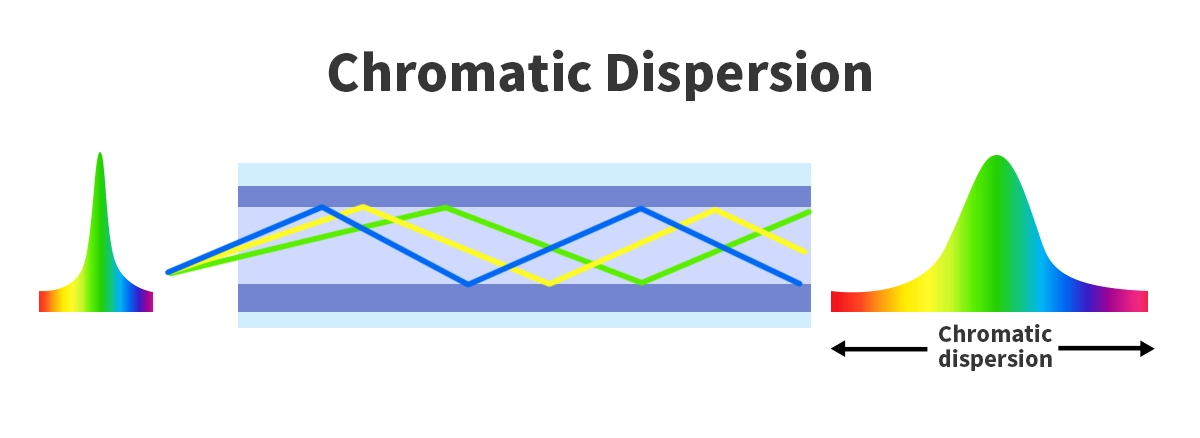
Chromatic dispersion (CD) is a fundamental phenomenon in fiber optic communications that can make or break network performance. As data rates soar to 100G, 400G, and beyond, understanding CD becomes critical for engineers, IT professionals, and anyone involved in high-speed networking. In this blog, we’ll dive deep into what chromatic dispersion is, its types, effects, and practical solutions—including how advanced optical transceivers like those from LINK-PP can help mitigate its impact.
🔍 Did you know? Chromatic dispersion is responsible for pulse broadening in optical fibers, limiting transmission distances and data integrity.
📑 What Is Chromatic Dispersion?
Chromatic dispersion refers to the spreading of light pulses as they travel through an optical fiber due to different wavelengths of light traveling at varying speeds. In simpler terms, it’s like a rainbow effect where colors (wavelengths) separate, causing signal distortion. This occurs because the refractive index of glass—the material used in fibers—changes with wavelength.
Key points:
Cause: Variation in the speed of light for different wavelengths.
Impact: Pulse broadening leads to intersymbol interference (ISI), errors, and reduced bandwidth.
Relevance: Critical in dense wavelength-division multiplexing (DWDM) systems and long-haul networks.
For example, in high-speed fiber optic networks, unchecked CD can degrade signals over distances as short as 50km.

📑 Types of Chromatic Dispersion
Chromatic dispersion is primarily categorized into two types, each with distinct characteristics:
Type | Description | Common Occurrence |
|---|---|---|
Material Dispersion | Caused by the wavelength-dependent refractive index of the fiber material (e.g., silica). | Standard single-mode fibers (SMF). |
Waveguide Dispersion | Results from the fiber’s geometric structure guiding light differently per wavelength. | Dispersion-shifted fibers (DSF). |
➡️ Pro Tip: In most networks, both types coexist, but material dispersion dominates in conventional fibers.
Additionally, polarization mode dispersion (PMD) is often discussed alongside CD, but it’s a separate effect related to polarization states.
📑 How Chromatic Dispersion Affects Fiber Optic Networks
CD isn’t just a theoretical concern—it has real-world implications:
Signal Degradation: Pulse spreading causes adjacent bits to overlap, increasing bit-error rates (BER).
Distance Limitations: Without compensation, CD caps the maximum transmission distance. For instance, in 10G networks, it can limit reach to ~80km in SMF.
Cost Implications: Mitigating CD often requires additional components, raising deployment costs.
📉 In long-haul optical communication systems, CD can reduce network efficiency by up to 30% if unaddressed. This is where chromatic dispersion compensation strategies become essential.
📑 Methods to Compensate for Chromatic Dispersion
To combat CD, engineers use various techniques. Here’s a quick overview:
Dispersion-Compensating Fiber (DCF): A specialized fiber with negative dispersion to offset CD in standard fibers.
Fiber Bragg Gratings (FBGs): Optical filters that reflect specific wavelengths to correct dispersion.
Digital Signal Processing (DSP): Algorithms in transceivers that electronically compensate for CD.
Optical Transceivers with Built-In Compensation: Modern modules integrate CD management directly.
✅ For optimal performance, combining multiple methods is common in high-density data centers and telecom networks.
📑 The Role of Optical Transceivers in Managing Chromatic Dispersion
Optical transceivers are the workhorses of fiber networks, converting electrical signals to light and vice versa. Today’s advanced transceivers go beyond basic functions—they incorporate features to handle chromatic dispersion dynamically.
How Transceivers Help:
Integrated DSP: Many high-speed optical transceivers use DSP chips to pre- and post-process signals, compensating for CD in real-time.
Tunable Lasers: These allow wavelength adjustments to minimize dispersion effects.
Coherent Technology: In coherent transceivers, CD is managed through sophisticated modulation schemes.
🌟 Spotlight on LINK-PP Solutions:
LINK-PP’s optical transceivers are engineered to tackle chromatic dispersion head-on. For instance, the 400G-ZR+ Coherent Transceiver leverages advanced DSP and tunable optics to deliver robust performance in dispersion-prone environments. This model supports up to 120km transmission with minimal BER, making it ideal for metro and long-haul applications.
By choosing LINK-PP products, you’re investing in reliability and future-proofing your network against CD-related issues.
📑 Conclusion
Chromatic dispersion is a key challenge in fiber optics, but with the right knowledge and tools, it’s manageable. From understanding its types to implementing compensation methods like those in LINK-PP optical transceivers, you can ensure high-speed, error-free data transmission.
🚀 Ready to Optimize Your Network?
Explore LINK-PP’s range of dispersion-tolerant optical transceivers, including the LINK-PP 400G-ZR+ transceiver, designed for seamless integration and superior performance. Contact our experts today to learn how we can help you overcome chromatic dispersion challenges!
📑 FAQ
What is chromatic dispersion in fiber optics?
Chromatic dispersion means colors move at different speeds in fiber. This makes the light pulse spread out. Signals can get harder to read.
What problems does chromatic dispersion cause?
Chromatic dispersion can make signals blurry. You might see data mistakes or slower speeds. Signals can mix, so your network may not work well.
What types of fiber are affected by chromatic dispersion?
Fiber Type | Effect of CD |
|---|---|
Single-mode | Less dispersion |
Multi-mode | More dispersion |
Multi-mode fiber has more problems with dispersion.
What can you do to manage chromatic dispersion?
You can check dispersion with special tools. Use dispersion compensating fiber or modules to fix spreading. Always test your network after you change things.
What happens if you ignore chromatic dispersion?
If you ignore chromatic dispersion, your network can get slow. Signals may not be clear. You could lose data or have more mistakes.


